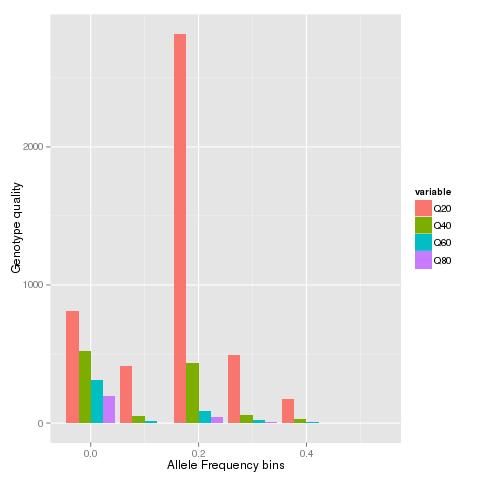A
recent paper, that used ancient DNA sequences from museum samples concluded that Bali, Javan and Sumatran tigers had a closer genetic relationship by comparing it with diagnostic mtDNA sequences from various other tiger subspecies.
Due to
lack of precise geographic information about the sampling locations, despite having a
matrix of genetic distances they could not look at isolation by distance patterns. The historical geographic ranges of these subspecies can be found on wikipedia. One could, just assume sampling locations within the geographic range and check if a pattern of IBD can be seen. While performing such assumptions in a paper might not be possible, a blog provides you some freedom to do so. However, somebody familiar with Tigers might be able to provide better assumptions.
The
R package sp provides many useful functions to deal with spatial data. We use the spDistsN1 function to get the using Euclidean or Great Circle distance between two co-ordinates.
library(sp)
library(reshape)
library("ecodist")
someCoords <- data.frame(long=c(136,102,107,101,102,104,110,115,85), lat=c(45,38,33,25,5,5,7,8,24))
apply(someCoords, 1, function(eachPoint) spDistsN1(as.matrix(someCoords), eachPoint, longlat=TRUE))->X
X[upper.tri(X)]->G
pop1<-c("ALT","ALT","ALT","ALT","ALT","ALT","ALT","ALT","VIR","VIR","VIR","VIR","VIR","VIR","VIR","AMO","AMO","AMO","AMO","AMO","AMO","COR","COR","COR","COR","COR","JAX","JAX","JAX","JAX","SUM","SUM","SUM","SON","SON","BAL")
pop2<-c("VIR","AMO","COR","JAX","SUM","SON","BAL","TIG","AMO","COR","JAX","SUM","SON","BAL","TIG","COR","JAX","SUM","SON","BAL","TIG","JAX","SUM","SON","BAL","TIG","SUM","SON","BAL","TIG","SON","BAL","TIG","BAL","TIG","TIG")
data.frame(pop1,pop2,G)->Geodist
Geodist2 <- with(Geodist, G)
nams <- with(Geodist, unique(c(as.character(pop1), as.character(pop2))))
attributes(Geodist2) <- with(Geodist, list(Size = length(nams),Labels = nams,Diag = FALSE,Upper = FALSE,method = "user"))
class(Geodist2) <- "dist"
read.table(file="Tiger_Fst.txt",header=TRUE,sep="\t",row.names = 1)->M
na.omit(melt(M))->N
data.frame(pop1,pop2,N$value)->Gendist
Gendist2 <- with(Gendist, N$value)
nams <- with(Gendist, unique(c(as.character(pop1), as.character(pop2))))
attributes(Gendist2) <- with(Gendist, list(Size = length(nams),Labels = nams,Diag = FALSE,Upper = FALSE,method = "user"))
class(Gendist2) <- "dist"
mantel(Geodist2 ~ Gendist2, nperm=10000)
mantelr pval1 pval2 pval3 llim.2.5% ulim.97.5%
-0.06313036 0.67800000 0.32230000 0.65900000 -0.25930292 0.12999925
jpeg("Tiger_isolation_by_distance.jpeg")
plot(G,N$value/(1-N$value),xlab="Distance in Km",ylab="Fst/(1-Fst) from mtDNA sequences",main="Isolation by Distance pattern",pch=16,col="blue",xlim=c(0,6000))
text(G,N$value/(1-N$value),labels=paste(pop1," ",pop2))
dev.off()
jpeg("Tiger_Fst_cladogram.jpeg")
hc = hclust(dist(Gendist2))
op = par(bg = "#DDE3CA")
plot(hc, col = "#487AA1", col.main = "#45ADA8", col.lab = "#7C8071", col.axis = "#F38630", lwd = 3, lty = 3, sub = "", hang = -1, axes = FALSE,xlab="",main="Tiger Fst cladogram")
axis(side = 2, at = seq(0, 400, 100), col = "#F38630", labels = FALSE, lwd = 2)
mtext(seq(0, 400, 100), side = 2, at = seq(0, 400, 100), line = 1, col = "#A38630", las = 2)
dev.off()
The mantel's test shows that the IBD pattern has a very weak negative correlation. This is not entirely unexpected, given the high values of Fst that are almost saturated. Would using more markers with greater resolution capture a IBD pattern? How strong are the bottlenecks?
They have already used the data to build a
phylogenetic tree and a network. As i need to do something different, i build a cladogram using the Fst matrix. While this cladogram shows that the SUM and BAL are close to each other, it fails to group SON with them. Various other differences from the phylogenetic tree can be seen.
























































